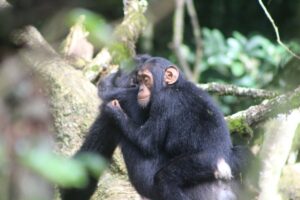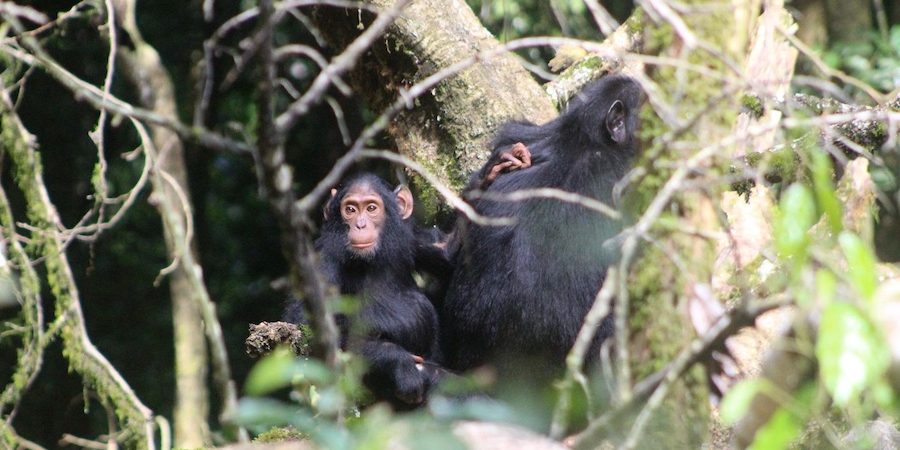Chimpanzees, alongside gorillas, orangutans, and humans, belong to the family of great apes. These remarkable creatures are distinguished by their highly developed brains, advanced problem-solving abilities, and an unparalleled capacity to use tools in daily life. Not only are chimpanzees incredibly intelligent, but they also closely resemble humans in their social structure and behaviors. They live in communities that mirror our own societies, making them fascinating subjects for study and interaction.
Chimpanzees have two main species: the common chimpanzee and the bonobo, or pygmy chimpanzee. While the common chimpanzee is found throughout much of Africa, from west to east, the bonobo is confined to the central tropical rainforests of the Democratic Republic of Congo (DRC). The common chimpanzee is more widely known, partly due to significant research by figures like Jane Goodall, whose studies have revealed that the two species differ in their diet, social structure, and habitat preferences.
Despite their wide distribution, chimpanzees are considered endangered by the International Union for Conservation of Nature (IUCN) due to habitat loss, hunting, and disease. With their numbers dwindling, efforts are underway across the globe to protect these amazing creatures, and Uganda plays a pivotal role in these conservation efforts, with chimpanzee trekking becoming a major attraction for eco-tourism. This activity allows visitors to encounter chimpanzees in their natural habitats, fostering awareness and contributing to their protection.
Chimpanzee Tracking in Uganda
Uganda is home to over 5,000 chimpanzees, making it one of the top destinations for primate trekking safaris. The country offers a variety of trekking locations, each with its own unique terrain and atmosphere. The different locations not only provide an opportunity to see chimpanzees but also offer a distinctive experience in terms of landscape, access, and overall atmosphere. The costs of chimpanzee trekking permits vary by location, with places like Kibale Forest National Park charging higher fees than other regions. Here are some of the top chimpanzee trekking destinations in Uganda:
- Kibale Forest National Park
 Kibale Forest National Park, located in western Uganda near the town of Fort Portal, is considered the “capital of primates” in Africa. This lush tropical rainforest is home to over 1,500 chimpanzees and is renowned for its high biodiversity, with 12 species of primates and a wide range of other wildlife. The park’s dense forest and diverse landscapes make it an ideal habitat for chimpanzees, which is why it remains one of the most popular destinations for chimpanzee trekking.
Kibale Forest National Park, located in western Uganda near the town of Fort Portal, is considered the “capital of primates” in Africa. This lush tropical rainforest is home to over 1,500 chimpanzees and is renowned for its high biodiversity, with 12 species of primates and a wide range of other wildlife. The park’s dense forest and diverse landscapes make it an ideal habitat for chimpanzees, which is why it remains one of the most popular destinations for chimpanzee trekking.
Trekking in Kibale is available in three daily sessions: early morning, mid-morning, and afternoon. Visitors can expect to spend 1-2 hours with the chimpanzees, observing them as they play, feed, and interact with each other. The chimpanzee trekking fee in Kibale is USD 250$ per person, and visitors are advised to book their permits in advance, especially during the peak seasons.
Kibale Forest is also home to other attractions such as the Bigodi Wetland Sanctuary, where visitors can enjoy a guided nature walk and see a variety of bird species. To make the most of the experience, many tourists opt for a 3-day chimpanzee trekking safari, which includes accommodation in eco-lodges and a deeper immersion into the park’s natural beauty.
- Kalinzu Forest
Located near Queen Elizabeth National Park, Kalinzu Forest is another prime spot for chimpanzee trekking. With over 290 chimpanzees, the forest offers one of the highest chances of spotting these primates in Uganda, with a 90% success rate for trekkers. However, Kalinzu is still relatively undeveloped in terms of tourism infrastructure, and the management of chimpanzee trekking here is under the Ministry of Forestry, rather than the Uganda Wildlife Authority.
Trekking in Kalinzu is quite affordable, with a permit costing USD 35$ per person. The forest is also home to a variety of other wildlife, including birds, monkeys, and reptiles, and trekkers can enjoy guided walks through the forest to learn more about its biodiversity. Due to its lower cost, Kalinzu provides an excellent alternative for those looking to experience chimpanzee tracking on a budget.
- Budongo Forest
Situated within the Murchison Falls Conservation Area, Budongo Forest is another key location for chimpanzee trekking in Uganda. With about 800 chimpanzees living in the forest, it is one of the largest chimpanzee populations in the country. A portion of these chimpanzees has been habituated for trekking, providing an opportunity for close encounters with these fascinating creatures.
Trekking in Budongo is carried out at Kaniyo Pabidi, a pristine section of the forest. Two trekking sessions are available: one in the morning, starting at 7 am, and another in the afternoon, starting at 2 pm. The cost for a chimpanzee trekking permit in Budongo is USD 85$ per person. The wet season, particularly from April to May and October to November, is the best time for trekking, as the chimpanzees are more likely to remain near the forest edges where food is plentiful.
- Kyambura Gorge
Kyambura Gorge, also known as the “Valley of Apes,” is located within Queen Elizabeth National Park. It offers a unique opportunity to combine chimpanzee trekking with game viewing in one location. The gorge is home to around 30 chimpanzees, and while sightings can be less predictable than in other areas, the trek through this magnificent valley adds an extra dimension to the experience.
The cost of chimpanzee trekking in Kyambura Gorge is USD 80$ per person, making it a more affordable option. However, due to the terrain and the occasional movement of the chimpanzees to deeper parts of the forest, sightings are not guaranteed. Kyambura Gorge is also a great spot for bird watching, with species such as the African Finfoot and falcons frequently spotted.
- Ngamba Island
For those looking for a more controlled and accessible chimpanzee experience, Ngamba Island is a popular choice. Located on Lake Victoria, Ngamba Island is home to a sanctuary that houses rescued chimpanzees from around Uganda. While visitors do not interact with the chimpanzees as closely as in the wild, Ngamba offers an opportunity to learn about the conservation efforts to protect these animals.
At Ngamba Island, chimpanzees live in a fenced forest area where they are cared for by a team of professionals. Visitors can observe the chimps through the mesh fence, offering a less immersive but still informative experience. Ngamba Island is ideal for those with limited time or mobility but still wishing to learn about and see chimpanzees in Uganda.
- Semuliki Wildlife Reserve
Semuliki Wildlife Reserve, located on the border between Uganda and the Democratic Republic of Congo, is lesser-known as a chimpanzee trekking destination. The chimpanzees here are still under study, with researchers from Indiana University monitoring their behavior. Semuliki is unique in that the chimpanzees here have been observed migrating from deep forests to open savannahs in search of food, which adds an interesting behavioral dimension to the trekking experience.
- Entebbe Wildlife Education Centre
Located in Entebbe, the Uganda Wildlife Education Centre (formerly known as the Entebbe Zoo) is another spot where visitors can observe chimpanzees. While this is more of a zoo experience, it still provides an opportunity to learn about Uganda’s wildlife, including its chimpanzees, which live in a fenced enclosure with a few trees.
Cost and Permit Information
The cost of chimpanzee trekking in Uganda varies depending on the location and the type of experience. The following are typical prices:
- Kibale Forest National Park: USD 250$ per person
- Kalinzu Forest: USD 35$ per person
- Budongo Forest: USD 85$ per person
- Kyambura Gorge: USD 80$ per person
- Ngamba Island: Costs vary, but it is generally considered an affordable option for those looking for a more controlled environment.
- Semuliki Wildlife Reserve: Prices are typically included in specialized safari packages.
Comparing Chimpanzee Tracking and Gorilla Trekking
 Both chimpanzee trekking tours and gorilla trekking safaris are incredible wildlife experiences, but they differ in several key ways. While both activities involve encountering great apes in their natural habitats, each offers a unique experience:
Both chimpanzee trekking tours and gorilla trekking safaris are incredible wildlife experiences, but they differ in several key ways. While both activities involve encountering great apes in their natural habitats, each offers a unique experience:
- Location: Gorillas are found in mountainous regions, specifically in Rwanda, Uganda, and the Democratic Republic of Congo, while chimpanzees are spread across the tropical rainforests of central, east, and west Africa.
- Cost: Gorilla trekking permits are significantly more expensive, costing USD 800$ per person, compared to chimpanzee trekking permits, which range from USD 35$ to 250$.
- Behavior and Interaction: Gorillas are slower and more grounded, making them easier to approach for personal interaction. In contrast, chimpanzees are highly active and agile, often moving quickly through the trees, making them harder to track and observe up close.
- Environment: Gorilla trekking typically takes place in highland areas with rugged terrain, making it more physically demanding. Chimpanzee trekking, by contrast, is generally less challenging due to the forested terrain they inhabit.
- Duration of Interaction: Visitors are allowed to spend one hour with the gorillas, while chimpanzee trekking can last from one to two hours, depending on the location.
Essentials and Etiquette of Chimpanzee Tracking
Before embarking on your chimpanzee trekking adventure, it’s important to be prepared. Here are a few essentials and tips to keep in mind:
- Physical Fitness: While chimpanzee trekking is generally less strenuous than gorilla trekking, it still involves walking for several hours in humid, forested terrain. A moderate level of fitness is recommended.
- What to Pack: Essentials include hiking boots, long pants, a long-sleeved shirt, insect repellent, sunscreen, water, snacks, and a rain jacket. A good camera with a zoom lens is also recommended for photography.
- Best Time to Go: The dry seasons from December to February and June to September are ideal for chimpanzee trekking. During these months, trails are more accessible, and chimpanzee sightings are more frequent.
- Rules: Maintain a distance of at least 8 meters from the chimpanzees, avoid direct eye contact, do not feed the animals, and follow the guide’s instructions at all times. Children under the age of 12 are generally not allowed to participate.
Chimpanzee trekking is one of the experiences on Uganda tours considered a life-changing experience that allows visitors to connect with one of our closest relatives in the animal kingdom. With a range of destinations and pricing options, there’s something for every traveler – from budget backpackers to luxury eco-tourists.





